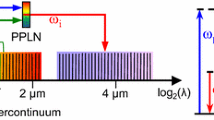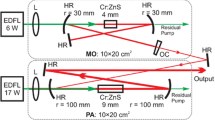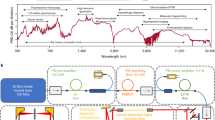Abstract
Heterodyne techniques have been used to experimentally determine, for the first time, the frequencies for nineteen laser emissions ranging from 264 to 984 GHz. These laser emissions were generated by optically pumping either CH3CN, CD3CN, \(^{13}\textit {CH}_{3}\)I, CD3I, or \(^{13}\textit {CD}_{3}\)I with a CO2 laser. This includes the newly discovered 566.325-μ m laser emission from optically pumped \(^{13}\textit {CD}_{3}\)I. The fractional uncertainties with which these frequencies were experimentally determined, up to ± 5 × 10− 7, were of sufficient accuracy to confirm or revise seven previously proposed far-infrared laser assignments.
Similar content being viewed by others
Avoid common mistakes on your manuscript.
1 Introduction
Direct discharge and optically pumped molecular lasers are capable of generating thousands of laser emissions in the far-infrared region [1,2,3]. The radiation from these sources have been used to investigate a variety of stable molecules and short-lived free radicals throughout this region of the electromagnetic spectrum.
Recently, we constructed an optically pumped molecular laser system that utilized a transverse, or “zig-zag,” excitation scheme [4]. Although this pumping scheme has been used previously [5,6,7,8], our experimental system has successfully generated over 600 laser emissions of which 130 were discovered in our lab. Given the wealth of far-infrared laser emissions this system has been capable of generating, we have focused recent efforts in experimentally determining the frequency for any far-infrared laser emission we observed. To date, we have experimentally determined over 170 far-infrared laser frequencies with this system. Our current work extends these efforts, in which we have experimentally determined for the first time the frequencies of nineteen far-infrared laser emissions belonging to either optically pumped CH3CN, CD3CN, \(^{13}\textit {CH}_{3}\)I, CD3I, or \(^{13}\textit {CD}_{3}\)I. Included in the present investigation is the discovery of a laser emission from \(^{13}\textit {CD}_{3}\)I, the confirmation of proposed spectroscopic assignments for six far-infrared laser emissions, and the revision of a previously proposed spectroscopic assignment for CD3I.
2 Experimental Methods
In this investigation, far-infrared radiation is generated using an optically pumped molecular laser system. This system uses a CO2 pump laser to excite the low pressure far-infrared sample housed in a second laser cavity (i.e., the FIR laser cavity). The far-infrared medium is excited by the CO2 pump laser’s infrared radiation using a transverse, or “zig-zag,” pumping scheme [4, 9]. Once far-infrared laser radiation is detected, its frequency is determined using the three-laser heterodyne technique, discussed in detail in Refs. [9,10,11]. Briefly, the far-infrared laser emission is mixed with radiation from two stabilized CO2 reference lasers with frequencies \(\nu _{\text {CO}_{2}\text {(I)}}\) and \(\nu _{\text {CO}_{2}\text {(II)}}\). The difference between these reference laser frequencies and the unknown far-infrared laser frequency is observed on a spectrum analyzer and the beat frequency is subsequently measured, νbeat, an example of which is shown in Fig. 1. The unknown far-infrared laser frequency, νFIR, is then calculated using
The lower trace on the spectrum analyzer display is the instantaneous beat observed when the 566.325-μ m laser emission is mixed with the stabilized 9P06 and 9P26 CO2 reference laser emissions. Once the instantaneous beat is observed, the far-infrared laser cavity is manually scanned across its gain curve by adjusting the position of one of the far-infrared laser cavity’s end mirrors using a micrometer dial. The upper trace, whose center is 358.10 MHz, is the maximum heterodyne signal recorded by the spectrum analyzer during this process
To experimentally determine the ± sign in Eq. 1, the far-infrared laser cavity is manually scanned across its gain curve by translating one of the far-infrared laser cavity’s end mirrors using a micrometer dial. A small shift in the beat frequency is subsequently observed on the spectrum analyzer that identifies the appropriate sign to use in this expression.
At least fourteen independent measurements of the beat frequency have been used to calculate each far-infrared laser frequency. Additionally, at least two distinct sets of CO2 reference laser lines were used to measure the beat frequency for each far-infrared laser emission. The experimental uncertainty reported in this work is derived from the precision of the measured beat frequencies, the symmetry and width of the broadened gain curve of the far-infrared laser, and the overall reproducibility of known frequencies with this system. The resulting one-sigma fractional uncertainty, Δν/ν, is at least ± 5 × 10− 7. All samples were commercially obtained with the following enrichments: ≥ 99.8% D for CD3CN, 99% 13C for \(^{13}\textit {CH}_{3}\)I, ≥ 99.5% D for CD3I, and 99% 13C and 99.5% D for \(^{13}\textit {CD}_{3}\)I.
3 Results
The far-infrared laser frequencies determined during this investigation are listed in Table 1. The laser emissions are arranged, by molecule, in order of the CO2 pump line by increasing wavelength. The corresponding wavelength and wavenumber were calculated for each far-infrared laser frequency using 1 cm− 1 = 29 979.2458 MHz. During this investigation, the frequencies for known laser emissions (e.g., the 788.481-μ m line for \(^{13}\textit {CD}_{3}\)I generated by 10P12 [12, 13]) were periodically measured and found to be in agreement with their published values.
4 Discussion
During this investigation, one far-infrared laser emission was discovered: the 566.325-μ m line generated by \(^{13}\textit {CD}_{3}\)I when pumped with the 10P46 CO2 laser emission. This 566.325-μ m line was observed to be parallel to the polarization of the CO2 pump laser radiation and have an optimal operating pressure of 13.3 Pa with an output power characterized as Very Weak (below 1 μ W of power). In comparison, the 554.336-μ m line was also observed using the 10P46 CO2 laser emission operating at the same offset frequency and with the same polarization. Although it also used an operating pressure of 13.3 Pa, its output power was characterized as Strong (between 0.1 and 1 mW of power).
Microwave and infrared data can be combined with experimentally determined laser frequencies to perform the spectroscopic assignment of far-infrared laser transitions. Table 2 outlines the assignments associated with seven laser transitions.
Chang and Bridges [14] first observed the CH3CN 441.178-μ m laser emission that was subsequently assigned by Arimondo and Inguscio [21] to be the ground state transition from JK = 376 → 366. Sarkkinen and co-workers [22] reaffirmed their assignment and calculated the laser frequency to be 22.66509 cm− 1. Although the experimentally determined laser frequency (22.6666 cm− 1) has been significantly improved by this investigation, it still differs from the calculated value by approximately 45 MHz, which is larger than expected. To determine our laser frequency, beat frequencies generated by three distinct sets of CO2 reference lasers (9R22 & 9P08, 9R04 & 9P22, 9P02 & 9P28) were used and there was no discernible variation among the measurements used to calculate this laser frequency. Although the author is unable to explain the larger than expected difference between the calculated and experimentally determined far-infrared laser frequency, the proposed transition remains as originally assigned.
For CD3CN, these lines were first observed by Gastaud, Redon, and Fourrier [15] in which they proposed the assignments: JK = 626 → 616 (for 304.468 μ m) and JK = 584 → 574 (for 329.863 μ m). Sarkkinen and co-workers [22] revised these transition assignments and their calculated frequencies, which are in agreement (to within 15 MHz and 2 MHz, respectively) with our experimental results.
While studying CH3I, Dyubko and co-workers [12] discovered the 543.078-μ m laser emission, generated using the 10P26 CO2 pump. This laser emission was later confirmed to belong to \(^{13}\textit {CH}_{3}\)I instead of its parent sample due to its natural abundance. Arimondo et al. [16] initially proposed the IR assignment that was later expanded to include the far-infrared laser transition [18]. Gastaud and co-workers [17] also investigated \(^{13}\textit {CH}_{3}\)I and were responsible for the discovery, and subsequent assignment, of the 354.315 μ m laser emission. Using the molecular constants derived by Alanko [23], the transition assignments and calculated frequencies for both \(^{13}\textit {CH}_{3}\)I laser emissions are found to be in excellent agreement (to within 1 MHz) with our experimental results.
Finally, for CD3I, Gastaud and co-workers proposed assignments for the 1 135.051- and 658.112-μ m laser emissions [17]. Using an updated set of molecular constants for CD3I [24], the calculated frequencies for both laser emissions are in excellent agreement (to within 1 MHz) with our experimental results. To accomplish this, a minor adjustment (modifying K from 7 to 6) was made to the assignment of the 658.112-μ m laser emission.
5 Conclusion
This work reports the first experimental determination of nineteen far-infrared laser frequencies generated by optically pumped CH3CN, CD3CN, \(^{13}\textit {CH}_{3}\)I, CD3I, and \(^{13}\textit {CD}_{3}\)I. One of these frequencies belong to a newly discovered laser emission from \(^{13}\textit {CD}_{3}\)I, six were used to confirm the proposed spectroscopic assignments of far-infrared laser emissions, and another was used to revise a previously proposed spectroscopic assignment for a laser emission generated by CD3I. Along with learning more about the laser medium itself, these frequencies can be used to conduct high-resolution spectroscopic investigations in the far-infrared region (e.g., laser magnetic resonance spectroscopy [25]).
Data Availability
The data is available upon request from the corresponding author.
References
Douglas, N.G.: Millimetre and Submillimetre Wavelength Lasers: A Handbook of CW Measurements. In: Walther, H. (ed.) Springer Series in Optical Sciences, vol. 61. Springer, Berlin, New York (1989). https://doi.org/10.1007/978-3-540-46095-4.
Moruzzi, G., Winnewisser, B.P., Winnewisser, M., Mukhopadhyay, I., Strumia, F. (eds.): Microwave, Infrared and Laser Transitions of Methanol: Atlas of Assigned Lines from 0 To 1258 − 1cm. CRC Press, Boca Raton, Florida (1995).
Weber, M.J. (ed.): Handbook of Laser Wavelengths vol. 1. CRC Press, Boca Raton, Florida (1998). https://doi.org/10.1201/9781315219639.
Jackson, M., Alves, H., Holman, R., Minton, R., Zink, L.R.: New cw optically pumped far-infrared laser emissions generated with a transverse or ‘zig-zag’ pumping geometry. Journal of Infrared, Millimeter, and Terahertz Waves 35(3):282–287 (2014). https://doi.org/10.1007/s10762-013-0031-2.
Dodel, G., Magyar, G., Véron, D.: Oscillator and superradiance characteristics of a ‘zig-zag’ pumped 66 μ m D2O-laser. Infrared Physics 18(5–6):529–538 (1978). https://doi.org/10.1016/0020-0891(78)90066-0.
Evenson, K.M., Saykally, R.J., Jennings, D.A., Curl, R.F., Brown, J.M.: Far Infrared Laser Magnetic Resonance. In: Moore, C.B. (ed.) Chemical and Biochemical Applications of Lasers vol. V, pp. 95–138. Academic Press, New York (1980). https://doi.org/10.1016/B978-0-12-505405-8.50008-3.
Hirose, H., Matsuda, H., Kon, S.: High power FIR NH3 laser using a folded resonator. International Journal of Infrared and Millimeter Waves 2(6):1165–1176 (1981). https://doi.org/10.1007/BF01007081.
Chantry, G.W. (ed.): Long-Wave Optics: The Science and Technology of Infrared and Near-milllmetre Waves vol. 1: Principles and 2: Applications, pp. 573–585. Academic Press, London (1984).
Jackson, M., Zink, L.R.: Characterizing far-infrared laser emissions and the measurement of their frequencies. Journal of Visualized Experiments 106:53399 (2015). https://doi.org/10.3791/53399.
Petersen, F.R., Evenson, K.M., Jennings, D.A., Wells, J.S., Goto, K., Jimènez, J.J.: Far infrared frequency synthesis with stabilized CO2 lasers: Accurate measurements of the water vapor and methyl alcohol laser frequencies. IEEE Journal of Quantum Electronics 11(10):838–843 (1975). https://doi.org/10.1109/JQE.1975.1068525.
Xu, L.-H., Lees, R.M., Vasconcellos, E.C.C., Zerbetto, S.C., Zink, L.R., Evenson, K.M.: Methanol and the optically pumped far-infrared laser. IEEE Journal of Quantum Electronics 32(3):392–399 (1996). https://doi.org/10.1109/3.485389.
Dyubko, S.F., Fesenko, L.D., Baskakov, O.I., Svich, V.A.: Application of the CD3I, CH3I, and CD3Cl molecules as active elements of optically pumped submillimeter lasers. Journal of Applied Spectroscopy 23(2):1114–1116 (1975). https://doi.org/10.1007/BF00611759. Translated from Zhurnal Prikladnoi Spektroskopii 23(2):317–320, August (1975).
DeMichele, A., Moretti, A., Pereira, D.: Optically pumped 13CD3I: new TeraHertz laser transitions. Applied Physics B 103(3):659–662 (2011). https://doi.org/10.1007/s00340-010-4231-3.
Chang, T.Y., McGee, J.D.: Millimeter and submillimeter-wave laser action in symmetric top molecules optically pumped via perpendicular absorption bands. IEEE Journal of Quantum Electronics 12(1):62–65 (1976). https://doi.org/10.1109/JQE.1976.1069037.
Gastaud, C., Redon, M., Fourrier, M.: New CW FIR laser actions and assignments in CD3CN and CD3Br. Infrared Physics 29(2–4):353–356 (1989). https://doi.org/10.1016/0020-0891(89)90075-4.
Arimondo, E., Glorieux, P., Oka, T.: Radio-frequency spectroscopy inside a laser cavity; “pure” nuclear quadrupole resonance of gaseous CH3I. Physical Review A 17(4):1375–1393 (1978). https://doi.org/10.1103/PhysRevA.17.1375.
Gastaud, C., Redon, M., Fourrier, M.: Further new CW FIR lasing investigations in CH3I, 13CH3I and CD3I: New lines and assignments. International Journal of Infrared and Millimeter Waves 8(9):1069–1081 (1987). https://doi.org/10.1007/BF01010812.
Arimondo, E.: Submillimeter lasers in methyl iodide and its isotopic species. In: Button, K.J., Inguscio, M., Strumia, F. (eds.) Reviews of Infrared and Millimeter Waves: Optically Pumped Far-infrared Lasers vol. 2, pp. 81–103. Springer, New York (1984). https://doi.org/10.1007/978-1-4613-2689-2.
Bertolini, A., Carelli, G., Ioli, N., Massa, C.A., Moretti, A., Strumia, F.: Optically pumped CW FIR laser: New submillimeter laser emissions from CH2DOH, CH3I, CD3I, and trioxymethylene. International Journal of Infrared and Millimeter Waves 18(6):1281–1284 (1997). https://doi.org/10.1007/BF02678232.
Penoyar, P., Johnson, E., McKnight, M., Jackson, M.: New optically pumped far-infrared laser emissions from 13CD3OH, 13CD3OD, CD3CN, and 13CD3I. IEEE Journal of Quantum Electronics 50(6):429–433 (2014). https://doi.org/10.1109/JQE.2014.2314284.
Arimondo, E., Inguscio, M.: Assignments of laser lines in optically pumped CH3CN. International Journal of Infrared and Millimeter Waves 1(3):437–458 (1980). https://doi.org/10.1007/BF01007325.
Sarkkinen, H., Paso, R., Anttila, R.: Assignment of methyl cyanide FIR laser lines. Infrared Physics & Technology 37(6):643–653 (1996). https://doi.org/10.1016/S1350-4495(96)00013-8.
Alanko, S.: The ν6 band of 13CH3I. Journal of Molecular Spectroscopy 147(2):406–413 (1991). https://doi.org/10.1016/0022-2852(91)90066-J.
Cho, H.-G., Schwendeman, R.H.: High-resolution infrared and infrared radiofrequency double-resonance spectroscopy of the ν2 band of CD3I. Journal of Molecular Spectroscopy 133(2):383–405 (1989). https://doi.org/10.1016/0022-2852(89)90199-9.
Jackson, M., Zink, L.R., Towle, J.P., Riley, N., Brown, J.M.: The rotational spectrum of the FeD radical in its X4Δ state, measured by far-infrared laser magnetic resonance. Journal of Chemical Physics 130(15):154311 (2009). https://doi.org/10.1063/1.3117182.
Funding
Open access funding provided by SCELC, Statewide California Electronic Library Consortium. This material is based upon work supported by the Washington Space Grant Consortium (Award No. NNX10AK64H) and Central Washington University.
Author information
Authors and Affiliations
Corresponding author
Ethics declarations
Competing Interests
The author declares no competing interests.
Additional information
Publisher’s Note
Springer Nature remains neutral with regard to jurisdictional claims in published maps and institutional affiliations.
Rights and permissions
Open Access This article is licensed under a Creative Commons Attribution 4.0 International License, which permits use, sharing, adaptation, distribution and reproduction in any medium or format, as long as you give appropriate credit to the original author(s) and the source, provide a link to the Creative Commons licence, and indicate if changes were made. The images or other third party material in this article are included in the article's Creative Commons licence, unless indicated otherwise in a credit line to the material. If material is not included in the article's Creative Commons licence and your intended use is not permitted by statutory regulation or exceeds the permitted use, you will need to obtain permission directly from the copyright holder. To view a copy of this licence, visit http://creativecommons.org/licenses/by/4.0/.
About this article
Cite this article
Jackson, M. New Far-Infrared Laser Frequencies Generated by CH3CN, CD3CN, \(^{13}\textit {CH}_{3}\)I, CD3I, and \(^{13}\textit {CD}_{3}\)I. J Infrared Milli Terahz Waves 44, 313–319 (2023). https://doi.org/10.1007/s10762-023-00910-9
Received:
Accepted:
Published:
Issue Date:
DOI: https://doi.org/10.1007/s10762-023-00910-9





